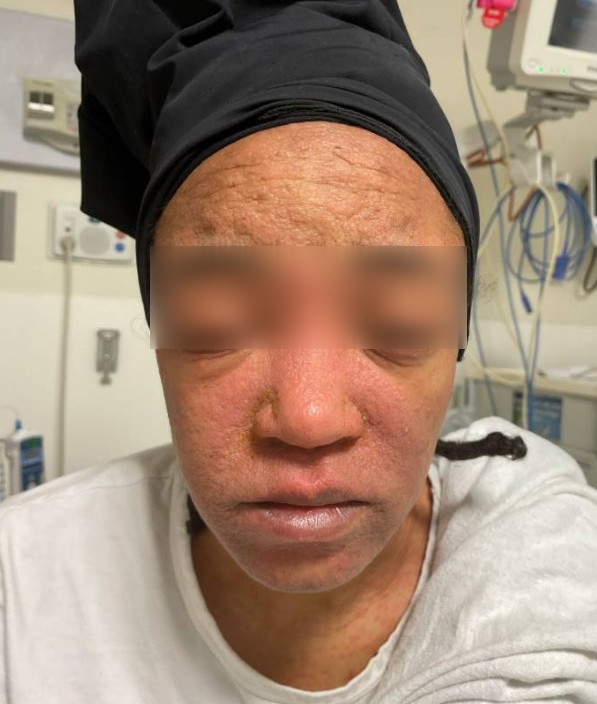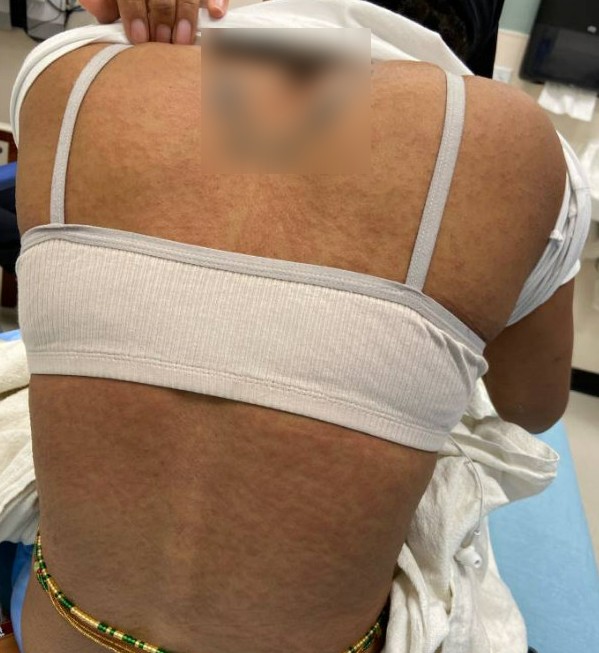Tuesday Poster Session
Category: IBD
P5536 - Sulfasalazine-Induced Drug Reaction With Eosinophilia and Systemic Symptoms (DRESS) Syndrome in Ulcerative Colitis
Tuesday, October 28, 2025
10:30 AM - 4:00 PM PDT
Location: Exhibit Hall

Michael B. Andrews, MD (he/him/his)
Virginia Commonwealth University Health System
Richmond, VA
Presenting Author(s)
Michael B. Andrews, MD, Michael V. Patrone, MD, Stephen J. Bickston, MD, FACG
Virginia Commonwealth University Health System, Richmond, VA
Introduction: Drug reaction with eosinophilia and systemic symptoms (DRESS) syndrome or drug-induced hypersensitivity syndrome (DIHS) is a rare and potentially life-threatening adverse drug reaction (ADR). It has a reported prevalence of 2 per 100,000 patients and a mortality rate of 10%, often secondary to fulminant hepatic failure. DRESS/DIHS typically presents two to six weeks after initiation of the culprit medication, although it can occur earlier with re-exposure.
Case Description/
Methods: A 34-year-old female with pancolitis UC was prescribed sulfasalazine. Five weeks later, she presented with intermittent high-grade fevers, chills, bloody diarrhea, and a pruritic rash. The rash first appeared on her neck then spread to her upper torso and face. On admission, she was febrile (39.7°C), tachycardic, and appeared uncomfortable, but had no signs of altered mental status. Facial edema and cervical lymphadenopathy were present. Skin exam was notable for pruritic coalescing erythematous macules and papules on her chest, abdomen, back, arms, and thighs.
Labs revealed leukocytosis with eosinophilia, elevated hepatic transaminases, and C reactive protein (CRP) 9.30 (0-0.5 mg/dL). Further acute liver injury workup ruled out viral, autoimmune, vascular, and biliary etiologies. CT abdomen/pelvis with contrast and MRI with magnetic resonance cholangiopancreatography (MRCP) revealed diffuse colitis without biliary abnormalities. Stool studies showed fecal leukocytes, stool calprotectin 1070 (0-120 ug/g), and negative stool pathogen direct testing.
Dermatology was consulted for co-management of DRESS/DIHS. Treatment involved escalating doses of steroids and cyclosporine until laboratory values stabilized.
Discussion: This case report describes a typical presentation of a rare ADR following five weeks of sulfasalazine for treatment of UC. It is imperative to promptly identify the ADR, remove the culprit medication, and work as a multi-disciplinary team to treat the patient. Careful long-term monitoring for both infectious complications as well as delayed extra-cutaneous manifestations is warranted.

Figure: Figure 1: Facial edema with pruritic coalescing erythematous macules and papules on her neck

Figure: Figure 2: Pruritic coalescing erythematous macules and papules on her back
Disclosures:
Michael Andrews indicated no relevant financial relationships.
Michael Patrone: Pfizer – Owned stock in Pfizer, but sold all shares in 2024. No longer hold any shares.
Stephen Bickston indicated no relevant financial relationships.
Michael B. Andrews, MD, Michael V. Patrone, MD, Stephen J. Bickston, MD, FACG. P5536 - Sulfasalazine-Induced Drug Reaction With Eosinophilia and Systemic Symptoms (DRESS) Syndrome in Ulcerative Colitis, ACG 2025 Annual Scientific Meeting Abstracts. Phoenix, AZ: American College of Gastroenterology.
Virginia Commonwealth University Health System, Richmond, VA
Introduction: Drug reaction with eosinophilia and systemic symptoms (DRESS) syndrome or drug-induced hypersensitivity syndrome (DIHS) is a rare and potentially life-threatening adverse drug reaction (ADR). It has a reported prevalence of 2 per 100,000 patients and a mortality rate of 10%, often secondary to fulminant hepatic failure. DRESS/DIHS typically presents two to six weeks after initiation of the culprit medication, although it can occur earlier with re-exposure.
Case Description/
Methods: A 34-year-old female with pancolitis UC was prescribed sulfasalazine. Five weeks later, she presented with intermittent high-grade fevers, chills, bloody diarrhea, and a pruritic rash. The rash first appeared on her neck then spread to her upper torso and face. On admission, she was febrile (39.7°C), tachycardic, and appeared uncomfortable, but had no signs of altered mental status. Facial edema and cervical lymphadenopathy were present. Skin exam was notable for pruritic coalescing erythematous macules and papules on her chest, abdomen, back, arms, and thighs.
Labs revealed leukocytosis with eosinophilia, elevated hepatic transaminases, and C reactive protein (CRP) 9.30 (0-0.5 mg/dL). Further acute liver injury workup ruled out viral, autoimmune, vascular, and biliary etiologies. CT abdomen/pelvis with contrast and MRI with magnetic resonance cholangiopancreatography (MRCP) revealed diffuse colitis without biliary abnormalities. Stool studies showed fecal leukocytes, stool calprotectin 1070 (0-120 ug/g), and negative stool pathogen direct testing.
Dermatology was consulted for co-management of DRESS/DIHS. Treatment involved escalating doses of steroids and cyclosporine until laboratory values stabilized.
Discussion: This case report describes a typical presentation of a rare ADR following five weeks of sulfasalazine for treatment of UC. It is imperative to promptly identify the ADR, remove the culprit medication, and work as a multi-disciplinary team to treat the patient. Careful long-term monitoring for both infectious complications as well as delayed extra-cutaneous manifestations is warranted.

Figure: Figure 1: Facial edema with pruritic coalescing erythematous macules and papules on her neck

Figure: Figure 2: Pruritic coalescing erythematous macules and papules on her back
Disclosures:
Michael Andrews indicated no relevant financial relationships.
Michael Patrone: Pfizer – Owned stock in Pfizer, but sold all shares in 2024. No longer hold any shares.
Stephen Bickston indicated no relevant financial relationships.
Michael B. Andrews, MD, Michael V. Patrone, MD, Stephen J. Bickston, MD, FACG. P5536 - Sulfasalazine-Induced Drug Reaction With Eosinophilia and Systemic Symptoms (DRESS) Syndrome in Ulcerative Colitis, ACG 2025 Annual Scientific Meeting Abstracts. Phoenix, AZ: American College of Gastroenterology.
